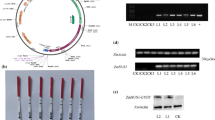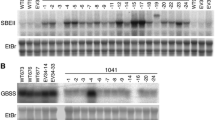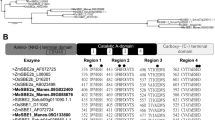Abstract
Main conclusion
RNAi technology was applied to suppress the expression of starch branching enzyme IIa and IIb and to increase amylose content in maize endosperm, and stably inherited high-amylose maize lines were obtained.
Amylose is an important material for industries and in the human diet. Maize varieties with endosperm amylose content (AC) of greater than 50 % are termed amylomaize, and possess high industrial application value. The high-amylose trait is controlled by multi-enzyme reaction and intricate gene–environment interaction. Starch branching enzymes are key factors for regulating the branching profiles of starches. In this paper, we report the successful application of RNAi technology for improving amylose content in maize endosperm through the suppression of the ZmSBEIIa and ZmSBEIIb genes by hairpin SBEIIRNAi constructs. These SBEIIRNAi transgenes led to the down-regulation of ZmSBEII expression and SBE activity to various degrees and altered the morphology of starch granules. Transgenic maize lines with AC of up to 55.89 % were produced, which avoided the significant decreases in starch content and grain yield that occur in high-amylose ae mutant. Novel maize lines with high AC offer potential benefits for high-amylose maize breeding. A comparison of gene silencing efficiency among transgenic lines containing different hpSBEIIRNA constructs demonstrated that (1) it was more efficient to use both ZmSBEIIa and ZmSBEIIb specific regions than to use the conserved domain as the inverted repeat arms; (2) the endosperm-specific promoter of the 27-kDa γ-zein provided more efficient inhibition than the CaMV 35S promoter; and (3) inclusion of the catalase intron in the hpSBEIIRNA constructs provided a better silencing effect than the chalcone synthase intron in the hpRNA construct design for suppression of the SBEII subfamily in endosperm.




Similar content being viewed by others
Abbreviations
- AC:
-
Amylose content
- ae:
-
Amylose-extender
- AGPase:
-
ADP-glucose pyrophosphorylase
- CTAB:
-
Cetyltrimethylammonium bromide
- DP:
-
Degree of polymerization
- DAP:
-
Days after pollination
- GBSS:
-
Granule-bound starch synthetase
- RNAi:
-
RNA interference
- SBE:
-
Starch branching enzymes
- DBE:
-
Starch debranching enzymes
- SS:
-
Starch synthetases
- WT:
-
Wild type
References
Béclin C, Boutet S, Waterhouse P, Vaucheret H (2002) A branched pathway for transgene-induced RNA silencing in plants. Curr Biol 12:684–688
Blauth SL, Yao Y, Klucinec JD, Shannon JC, Thompson DB, Guiltinan MJ (2001) Identification of Mutator insertional mutants of starch-branching enzyme 2a in corn. Plant Physiol 125:1396–1405
Blauth SL, Kim K-N, Klucinec J, Shannon JC, Thompson D, Guiltinan M (2002) Identification of Mutator insertional mutants of starch-branching enzyme 1 (sbe1) in Zea mays L. Plant Mol Biol 48:287–297
Boyer CD, Preiss J (1981) Evidence for independent genetic control of the multiple forms of maize endosperm branching enzymes and starch synthases. Plant Physiol 67:1141–1145
Burton RA, Bewley JD, Smith AM, Bhattacharyya MK, Tatge H, Ring S, Bull V, Hamilton W, Martin C (1995) Starch branching enzymes belonging to distinct enzyme families are differentially expressed during pea embryo development. Plant J 7:3–15
Butardo VM, Fitzgerald MA, Bird AR, Gidley MJ, Flanagan BM, Larroque O, Resurreccion AP, Laidlaw HK, Jobling SA, Morell MK (2011) Impact of down-regulation of starch branching enzyme IIb in rice by artificial microRNA-and hairpin RNA-mediated RNA silencing. J Exp Bot 62:4927–4941
Chuang C-F, Meyerowitz EM (2000) Specific and heritable genetic interference by double-stranded RNA in Arabidopsis thaliana. Proc Nat Acad Sci USA 97:4985–4990
Denyer K, Johnson P, Zeeman S, Smith AM (2001) The control of amylose synthesis. J Plant Physiol 158:479–487
Fisher DK, Gao M, Kim K-N, Boyer CD, Guiltinan MJ (1996) Allelic analysis of the maize amylose-extender locus suggests that independent genes encode starch-branching enzymes IIa and IIb. Plant Physiol 110:611–619
Friedman RB, Deboer ED, Delgado GA, Furcsik SL, Qvyjt F, Tenbarge FL (1999) Targeting of an appropriate amylose type starch for specific product applications. Macromol Symp 140:81–91
Gao M, Fisher DK, Kim K-N, Shannon JC, Guiltinan MJ (1996) Evolutionary conservation and expression patterns of maize starch branching enzyme I and IIb genes suggests isoform specialization. Plant Mol Biol 30:1223–1232
Gao M, Fisher DK, Kim K-N, Shannon JC, Guiltinan MJ (1997) Independent genetic control of maize starch-branching enzymes IIa and IIb: isolation and characterization of a Sbe2a cDNA. Plant Physiol 114:69–78
Garwood DL, Shannon J, Creech R (1976) Starches of endosperms possessing different alleles at the amylose-extender locus in Zea mays L. Cereal Chem 53:355–364
Guan H, Preiss J (1993) Differentiation of the properties of the branching isozymes from maize (Zea mays). Plant Physiol 102:1269–1273
Guan H, Li P, Imparl-Radosevich J, Preiss J, Keeling P (1997) Comparing the properties of Escherichia coli branching enzyme and maize branching enzyme. Arch Biochem Biophys 342:92–98
Guan S, Wang P, Liu H, Liu G, Ma Y, Zhao L (2011) Production of high-amylose maize lines using RNA interference in sbe2a. Afr J Biotechnol 10:15229–15237
Guo Z, Zhang J, Wang D, Chen Z (2008) Using RNAi technology to produce high-amylose potato plants. Sci Agric Sin 41:494–501
Hedman KD, Boyer CD (1983) Allelic studies of the amylose-extender locus of Zea mays L.: levels of the starch branching enzymes. Biochem Genet 21:1217–1222
Heilersig H, Loonen A, Bergervoet M, Wolters A, Visser R (2006) Post-transcriptional gene silencing of GBSSI in potato: effects of size and sequence of the inverted repeats. Plant Mol Biol 60:647–662
Hennen-Bierwagen TA, Liu F, Marsh RS, Kim S, Gan Q, Tetlow IJ, Emes MJ, James MG, Myers AM (2008) Starch biosynthetic enzymes from developing maize endosperm associate in multisubunit complexes. Plant Physiol 146:1892–1908
Hirai S, Kodama H (2008) RNAi vectors for manipulation of gene expression in higher plants. Open Plant Sci J 2:21–30
Hofvander P, Andersson M, Larsson CT, Larsson H (2004) Field performance and starch characteristics of high-amylose potatoes obtained by antisense gene targeting of two branching enzymes. Plant Biotechnol J 2:311–320
Jeon J-S, Ryoo N, Hahn T-R, Walia H, Nakamura Y (2010) Starch biosynthesis in cereal endosperm. Plant Physiol Biochem 48:383–392
Jobling SA, Schwall GP, Westcott RJ, Sidebottom CM, Debet M, Gidley MJ, Jeffcoat R, Safford R (1999) A minor form of starch branching enzyme in potato (Solanum tuberosum L.) tubers has a major effect on starch structure: cloning and characterisation of multiple forms of SBE A. Plant J 18:163–171
Krogars K, Heinämäki J, Karjalainen M, Niskanen A, Leskelä M, Yliruusi J (2003) Enhanced stability of rubbery amylose-rich maize starch films plasticized with a combination of sorbitol and glycerol. Int J Pharm 251:205–208
Kuriki T, Stewart DC, Preiss J (1997) Construction of chimeric enzymes out of maize endosperm branching enzymes I and II: activity and properties. J Biol Chem 272:28999–29004
Li L, Jiang H, Campbell M, Blanco M, J-l Jane (2008) Characterization of maize amylose-extender (ae) mutant starches. Part I: relationship between resistant starch contents and molecular structures. Carbohydr Polym 74:396–404
Li N, Zhang S, Zhao Y, Li B, Zhang J (2011) Over-expression of AGPase genes enhances seed weight and starch content in transgenic maize. Planta 233:241–250
Lourdin D, Valle GD, Colonna P (1995) Influence of amylose content on starch films and foams. Carbohydr Polym 27:261–270
Martin C, Smith AM (1995) Starch biosynthesis. Plant Cell 7:971–985
Matveev YI, Van Soest J, Nieman C, Wasserman L, Protserov V, Ezernitskaja M, Yuryev V (2001) The relationship between thermodynamic and structural properties of low and high amylose maize starches. Carbohydr Polym 44:151–160
Mizuno K, Kimura K, Arai Y, Kawasaki T, Shimada H, Baba T (1992) Starch branching enzymes from immature rice seeds. J Biochem 112:643–651
Moore CW, Creech RG (1972) Genetic fine structure analysis of the amylose-extender locus in Zea mays L. Genetics 70:611–619
Morell MK, Blennow A, Kosar-Hashemi B, Samuel MS (1997) Differential expression and properties of starch branching enzyme isoforms in developing wheat endosperm. Plant Physiol 113:201–208
Nelson O, Pan D (1995) Starch synthesis in maize endosperms. Annu Rev Plant Biol 46:475–496
Poulsen P, Kreiberg JD (1993) Starch branching enzyme cDNA from Solanum tuberosum. Plant Physiol 102:1053–1054
Regina A, Kosar-Hashemi B, Li Z, Pedler A, Mukai Y, Yamamoto M, Gale K, Sharp PJ, Morell MK, Rahman S (2005) Starch branching enzyme IIb in wheat is expressed at low levels in the endosperm compared to other cereals and encoded at a non-syntenic locus. Planta 222:899–909
Regina A, Bird A, Topping D, Bowden S, Freeman J, Barsby T, Kosar-Hashemi B, Li Z, Rahman S, Morell M (2006) High-amylose wheat generated by RNA interference improves indices of large-bowel health in rats. Proc Nat Acad Sci USA 103:3546–3551
Regina A, Kosar-Hashemi B, Ling S, Li Z, Rahman S, Morell M (2010) Control of starch branching in barley defined through differential RNAi suppression of starch branching enzyme IIa and IIb. J Exp Bot 61:1469–1482
Saurabh S, Vidyarthi AS, Prasad D (2014) RNA interference: concept to reality in crop improvement. Planta 239:543–564
Schmidt MA, Herman EM (2008) Suppression of soybean oleosin produces micro-oil bodies that aggregate into oil body/ER complexes. Mol Plant 1:910–924
Schmidt MA, Barbazuk WB, Sandford M, May G, Song Z, Zhou W, Nikolau BJ, Herman EM (2011) Silencing of soybean seed storage proteins results in a rebalanced protein composition preserving seed protein content without major collateral changes in the metabolome and transcriptome. Plant Physiol 156:330–345
Schwall GP, Safford R, Westcott RJ, Jeffcoat R, Tayal A, Shi Y-C, Gidley MJ, Jobling SA (2000) Production of very-high-amylose potato starch by inhibition of SBE A and B. Nat Biotechnol 18:551–554
Smith AM (1990) Evidence that the “waxy” protein of pea (Pisum sativum L.) is not the major starch-granule-bound starch synthase. Planta 182:599–604
Sun C, Sathish P, Ahlandsberg S, Jansson C (1998) The two genes encoding starch-branching enzymes IIa and IIb are differentially expressed in barley. Plant Physiol 118:37–49
Takeda Y, Guan H, Preiss J (1993) Branching of amylose by the branching isoenzymes of maize endosperm. Carbohydr Res 240:253–263
Wang Y, White P, Pollak L, Jane J (1993) Characterization of starch structures of 17 maize endosperm mutant genotypes with Oh43 inbred line background. Cereal Chem 70:171–179
Wesley SV, Helliwell CA, Smith NA, Wang M, Rouse DT, Liu Q, Gooding PS, Singh SP, Abbott D, Stoutjesdijk PA (2001) Construct design for efficient, effective and high-throughput gene silencing in plants. Plant J 27:581–590
Yandeau-Nelson MD, Laurens L, Shi Z, Xia H, Smith AM, Guiltinan MJ (2011) Starch-branching enzyme IIa is required for proper diurnal cycling of starch in leaves of maize. Plant Physiol 156:479–490
Zhao FM, Qi X, Xiao J, Wang XZ (2007) Improved method for determining starch branching enzyme activity. Plant Physiol Comm 6:1167–1169
Zhu L, Liu Q, Sang Y, Gu M, Shi Y (2010) Underlying reasons for waxy rice flours having different pasting properties. Food Chem 120:94–100
Zhu L, Gu M, Meng X, Cheung SC, Yu H, Huang J, Sun Y, Shi Y, Liu Q (2012) High-amylose rice improves indices of animal health in normal and diabetic rats. Plant Biotechnol J 10:353–362
Acknowledgments
We thank Liu, Q., Zhang, C., and Man, J. (Key Laboratories of Crop Genetics and Physiology of the Jiangsu Province and Plant Functional Genomics of the Ministry of Education, Yangzhou University) for assistance in GPC analysis. We thank Cong, H. (Life Science College of Shandong University) for help on performing SEM for observing the morphology of starch granules. We thank Li, S. (Life Science College of Shandong University) for the maize shoot-tip genetic transformation and cultivation. This work was supported by the Hi-Tech Research and Development (863 Program of China, 2012AA10A306).
Author information
Authors and Affiliations
Corresponding author
Electronic supplementary material
Below is the link to the electronic supplementary material.
Rights and permissions
About this article
Cite this article
Zhao, Y., Li, N., Li, B. et al. Reduced expression of starch branching enzyme IIa and IIb in maize endosperm by RNAi constructs greatly increases the amylose content in kernel with nearly normal morphology. Planta 241, 449–461 (2015). https://doi.org/10.1007/s00425-014-2192-1
Received:
Accepted:
Published:
Issue Date:
DOI: https://doi.org/10.1007/s00425-014-2192-1




